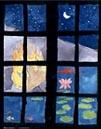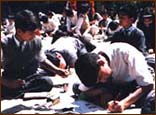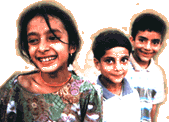|
There were 495 children at the competition. All normal, schoolgoing youngsters. Of normal, conscientious parents. Sprawled out all over the grassy ground that sunny morning, partaking in Srinagar's first painting competition in nearly 10 years, they drew with passion. First, the brisk, light pencil sketches. Then, the broader, bolder crayon strokes. The fill-ins, the touch-ups...
The majority, instead, were of the Kashmir of violence, the Kashmir of turbulence. Of guns, grenades and gore. And Mujahid (militant), kabr (grave) and shaheed (martyr). The paintings opened a window to the scarred psyche of the children of Kashmir, the children of conflict... The results proclaimed the fact. The violent colours the youngsters used in abundance corroborated it. Many -- probably a majority -- of the children in Kashmir (not the 10,000-odd orphans of militancy, but the average, schoolgoing, normal kids) have deep, permanent bruises of the mind. Bruises that have far-reaching consequences, that are now finding reflection in psychic disorders, drug abuse and personality changes. That extra-sensitivity and extra-irritability, that extra-aggression, those distressing fits of temper and those equally distressing bouts of depression -- that's what nine years of militancy have gifted Kashmir's new generation. Medical statistics confirm this. The number of reported psychiatric patients in the valley (adults included) showed a 10-fold increase in the five years since 1990. And this is hardly indicative of child illhealth -- for in the valley, where trained psychiatrists are a rare breed (the Government Medical College, for instance, functions with a faculty of two!), most of the mental illnesses are, more often than not, treated for their physical symptoms. "More than 50 per cent of the paintings had underlying themes of violence," said Funkar Cultural Organisation general secretary Hazrath Gadda, the man behind the competition. "The valley was witnessing such a competition in a long time, and the response was excellent -- in fact, much more than we expected. But the results, too, were a bit shocking. Bar a few, none of the paintings were the type you would expect a child to do." There were paintings of encounters, paintings of explosions, paintings of killings, and paintings of fire -- some sad, some satirical, some subdued, some aggressive, they all told the same tale. In his little corner, a frown of concentration creasing his chubby face, eight-year-old Mohammed Arsalan Dhar was furiously sketching a burning Charer-e-Sharief. While armed soldiers looked on from behind sandbags, yellow flames were devouring the magnificent structure. At its entrance was a mother, with her dead son in her arms. Dhar is normal, belongs to a middle class family, has never really witnessed a violent incident in his life -- yet this is his vision of Kashmir. He looked flustered for a minute, when asked why he chose to draw a Charar-e-Sharief in flames. "That's what came to my mind first when they told me the subject," he blurted. A pause, a slight shake of the head, and the youngster attempted again. "I read papers. I have seen pictures of it burning and soldiers looking on and..."
"Because... because there are militants and firings and killings all around," she finally managed. If Dhar and Mushtaq represent the rather subdued group among the child-painters, Shahil Yousef's work is remarkably direct. The 10-year-old's Kashmir Valley Today, Kashmir Valley Tomorrow visualises the future as an ugly, leering skeleton. These were not all. There were other paintings, equally violent, equally potent. Like The Wounded Paradise, Let Us Play Firing, Firing, Save Our Valley, The Distributed Fingers, My Valley Through Our Window, The Valley Is In Danger... and scores more. Waking up to gunwielding securitymen in the middle of the night, and being bundled out of the house unceremoniously while they go ahead with the oh-so-frequent search operations, is a terrifying experience. The children of Kashmir will vouch for that. So is waking up to a house full of militants -- or troops, for that matter. And hearing the roar of explosions close by and knowing not which way to turn, whether to hide or to run. So, too, is waking up to shuttered windows that never open till the sun is well up, and clamp down much before it sinks. Day after day, for years. And hearing the mothers's anxious admonishments not to stray out of the house, not to play on the roadside, never to leave the door open, never ever to go out after sundown. But worst of all is the fear they see in their parents' eyes, the tension they absorb from their elders. The uncertainty that's mirrored alike in the eyes of the lawman and the rebel.
His gnarled fingers sorted through the pile rapidly and came up with a bunch. "If you notice," he continued, handing it over, "you will see many of these are done in red, grey and black. The children have used these colours expansively -- that's their way of communicating their inner turmoil." Gadda's theory gets ample backing from the medical community. "It is not the conscious mind alone that's active when you indulge in such activities -- your subconsciousness too come very much into the picture," explained Dr Mushtaq Ahmad Margoob, senior consultant at Srinagar's Government Medical College. "When the child indulges much in these colours, he is expressing extremes of emotions. It reflects the same thing which we have been clinically observing." Dr Margoob offers the results of his study as proof. His project, conducted at the Hospital for Psychiatric Diseases (which, incidentally, is the sole such specialised institution in Srinagar), concludes that the reported psychiatric morbidity in patients has shot up from a mere nine per cent in the pre-militancy days to 25 per cent in 1995.
The number of child patients, he added, has gone up by the same ratio, if not more. "Even otherwise, children go through a lot of crisis during adolescence. On top of this, they have had to put with the uncommon tension all around. This has forced them to bottle their natural aggression, their fears," the doctor went on. "Everything builds up in them and comes out as conduct and behavioural disorders, irritability, distractibility, aggression and the like." Two other significant observations which the specialist noted during his study (The Pattern of Child Psychiatric Disorders in Kashmir) were the sharp rise in dissociative disorders (to the rate of almost 50 per cent) and the prevalence of post-traumatic stress disorders. "PTSD is extremely uncommon in a child. The increasing number of such cases -- from nil to 3 per cent -- is a response to a stressful or threatening event, and can be directly linked to the situation here," he said. Another result of militancy, medicos note with alarm, is the drug habit which many youngsters have picked up. They give three reasons for this -- one, the children are more exposed to this menace as many of them have to go out and earn their livelihoods. Two,
"We are on the verge of a drug disaster," warned Dr Margoob. "Many of the youth are dependent on narcotics -- mainly charas and tranquilisers." Three-year-olds demanding grenades to play with is not strange in Kashmir. It cannot be, not at a place where children are more familiar with crackdowns, encounters and curfew than, say, picnics, cinema or, even, icecream. It is definitely not strange at a place where they would rather play 'Soldiers and Militants' than 'Cops and Robbers'. "Invariably, no one wants to be a soldier -- the militants are their heroes," says a school teacher who requested anonymity. "These children have been cheated out of their childhood. They have not really played, they have not been to picnics, they have not even walked the open without fear," says Dr Altaf Hussain, a leading paediatrician in the city. "All this repression is bound to come out sooner or later." Consequently, many child specialists in the city have noticed increased incidents of nail biting, aggression, bedwetting, nightmares...
"Mental health is not easily quantifiable, but I would say
that over 60 per cent of the children here have been bruised badly,"
says Dr Hussain. "Child health starts from the time a child
"Unless congenial atmosphere is restored, these problems will not disappear," holds Dr Hussain, "If that happens, then most of these children will grow towards healthier ways. If not..." Tell us what you think of this feature
|

 On 495 sheets of paper, their dream Kashmir - 'My Valley' -- was
coming alive. But not many were of that paradise on earth, the
Kashmir of unsurpassed beauty. Not many were of snowclad mountains
and lush green valleys.
On 495 sheets of paper, their dream Kashmir - 'My Valley' -- was
coming alive. But not many were of that paradise on earth, the
Kashmir of unsurpassed beauty. Not many were of snowclad mountains
and lush green valleys.




 is in the mother's womb. The intelligence of a child is shaped
by the environment which the foetus gets there -- but mothers
have been absolutely terrified for the past so many years. And
that's affecting our children now."
is in the mother's womb. The intelligence of a child is shaped
by the environment which the foetus gets there -- but mothers
have been absolutely terrified for the past so many years. And
that's affecting our children now."